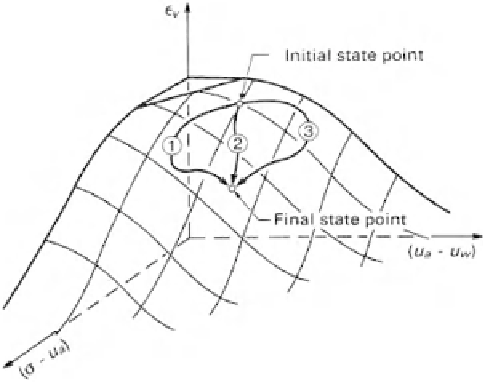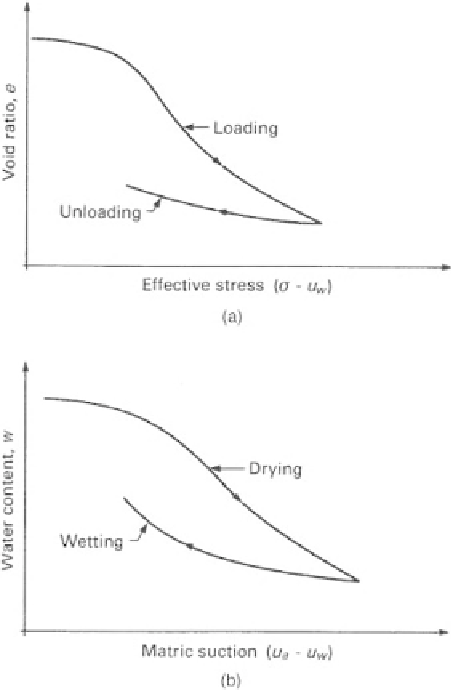Environmental Engineering Reference
In-Depth Information
deformation properties are outlined prior to describing the
results of tests for uniqueness.
The two constitutive surfaces for an unsaturated soil (i.e.,
soil structure and water phase) require experimental data in
order to examine the uniqueness of the proposed surfaces.
The term “uniqueness” is used to indicate that there is one
and only one relationship between the deformation and stress
state variables. Figure 13.11 illustrates the meaning of the
term uniqueness as applied to a constitutive surface. Let
us assume that three identical soil specimens have been pre-
pared at the same initial state point. The stress state variables
for the three specimens are then moved along three different
stress paths. However, the final stress state variables for the
three soil specimens are identical. The final combination of
stress state variables should produce the same deformation
state if the constitutive surface is unique. In other words, the
final volumes for the three soil specimens should be equal
and independent of the stress path.
Complete uniqueness of a constitutive relationship under
loading and unloading conditions is known to be virtually
impossible for soils. Hysteresis is the main reason that unique-
ness does not exist when going from loading to unloading
conditions or vice versa. Hysteresis is associated with a par-
ticulate material such as that comprising the soil structure.
Wetting and drying studies have also shown that the contrac-
tile skin also exhibits hysteresis. The soil structure hysteresis
during loading and unloading of a saturated soil is reflected
by the different compression and rebound curves for the soil
(Fig. 13.12a). The two curves are distinctly different under
loading and unloading conditions.
Hysteresis associated with contractile skin can be observed
from the drying and wetting curves of an incompressible
material such as chalk (Fig. 13.12b). It is quite clear that
there should be hysteresis associated with the soil structure
and the contractile skin in an unsaturated soil. It appears that a
reversal in the direction of deformation (i.e., an increase and
Figure 13.12
Hysteresis associated with soil structure and con-
tractile skin of a soil: (a) loading and unloading curves for saturated
soil; (b) drying and wetting curves for incompressible chalk.
then a decrease in volume) results in different constitutive
surfaces. As a result, the volumetric deformation coefficients
associated with a decreasing volume would be different from
those associated with an increasing volume.
Uniqueness of the constitutive surfaces with respect to
volume increase and decrease can be independently veri-
fied. This involves tracing the surface through various load-
ing paths provided the deformation state variable always
changes in the same direction (i.e., monotonic or unidirec-
tional deformation). The term uniqueness has been generally
restricted in soil mechanics to the consideration of constitu-
tive surfaces representing monotonic deformation.
The uniqueness of the soil structure constitutive surface can
be verified for either a decrease or an increase in the soil vol-
ume. Inaddition, theuniqueness of thewater phase constitutive
surface can also be verified for either a decrease or an increase
in the volume of water (i.e., drying or wetting surface).
13.4.4 Sign Convention for Volumetric Deformation
Properties
The sign convention for a general relationship between
deformation and stress state variable changes is illustrated
Figure 13.11
Principle involved in testing for uniqueness of
unsaturated soil constitutive surface.











Search WWH ::

Custom Search